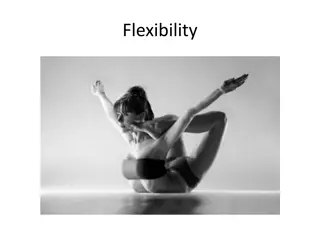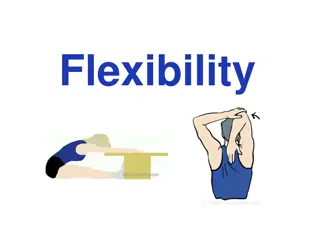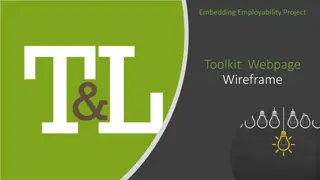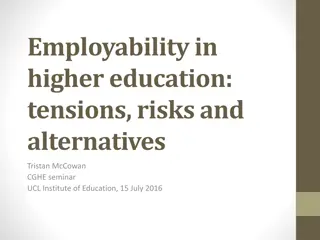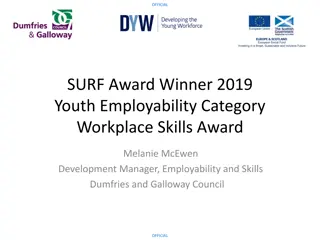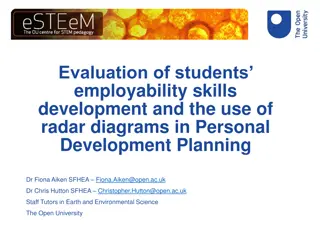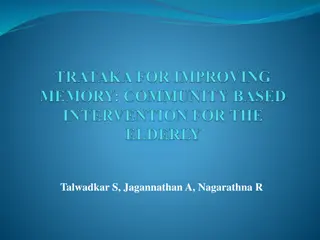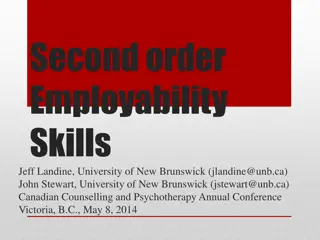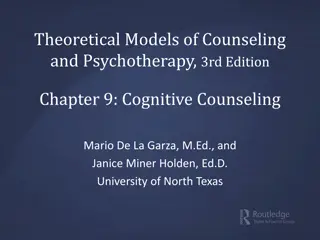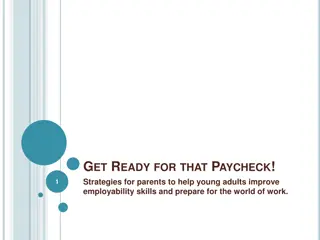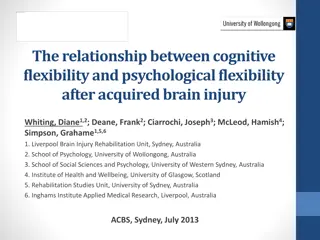Enhancing Cognitive Flexibility for Employability
Cognitive flexibility is a crucial skill for adapting to new situations and problem-solving in today's competitive job market. This module focuses on identifying, assessing, and enhancing cognitive flexibility to nurture competitiveness and employability. Learn how to recognize the importance of cognitive flexibility, use assessment tools, and apply techniques to improve this essential skill. With the support of the Erasmus+ program, this resource provides valuable insights into the role of cognitive flexibility in personal and professional development.
Uploaded on Sep 24, 2024 | 0 Views
Download Presentation

Please find below an Image/Link to download the presentation.
The content on the website is provided AS IS for your information and personal use only. It may not be sold, licensed, or shared on other websites without obtaining consent from the author. Download presentation by click this link. If you encounter any issues during the download, it is possible that the publisher has removed the file from their server.
E N D
Presentation Transcript
Enhance Soft Skills to Nurture Competitiveness and Employability Cognitive flexibility PARTNER: SSE Riga
OBJECTIVES AND GOALS At the end of this module you will be able to: Identify cognitive flexibility Recognize the role and importance of cognitive flexibility as a future skill Recognize and use instruments to assess cognitive flexibility Know and apply techniques to enhance cognitive flexibility
INDEX 3 Enhancing and training 1 What is cognitive flexibility and why does it matter for employability? 2 Assessing the level of cognitive flexibility
Unit 1 What is Cognitive Flexibility? Cognitive flexibility (CF) is the human ability to adapt the cognitive processing strategies to face new and unexpected conditions in the environment (Ca as et al. 2003). With the support of the Erasmus+ programme of the European Union. This document and its contents reflects the views only of the authors, and the Commission cannot be held responsible for any use which may be made of the information contained therein.
Unit 1 What is cognitive flexibility? + Solving Problems Thinking Critically Connecting Ideas Synthesizing Information Bending Twisting Thinking about things differently Changing approaches when needed With the support of the Erasmus+ programme of the European Union. This document and its contents reflects the views only of the authors, and the Commission cannot be held responsible for any use which may be made of the information contained therein.
Unit 1 What is cognitive flexibility? Alternative definitions The brain s ability to transition from thinking about one concept to another. The quicker you are able to switch or shift your thinking from one dimension to another, the greater your level of cognitive flexibility Ability to think flexibly and to shift perspectives and approaches easily Intrinsic property of a cognitive system often associated with the mental ability to adjust its activity and content, switch between different task rules and corresponding behavioral responses, maintain multiple concepts simultaneously and shift internal attention between them (William, 1962) For more academic definitions of CF see Ionescu (2012) Alternative terminology: in neuroscience, CF is sometimes referred to as attention switching, cognitive shifting, mental flexibility, set shifting, and task switching * Scott, William A. (December 1962). "Cognitive complexity and cognitive flexibility". Sociometry. 25 (4): 405 414. doi:10.2307/2785779. JSTOR 2785779. ** Ionescu (2012). Exploring the nature of cognitive flexibility. New ideas in psychology, 30(2), 190-200.) With the support of the Erasmus+ programme of the European Union. This document and its contents reflects the views only of the authors, and the Commission cannot be held responsible for any use which may be made of the information contained therein.
Unit 1 What is cognitive flexibility? Analogy Changing channels on a TV: think of the channels as streams-of-thought and the TV as your brain If you are stuck on one channel and can t change it your cognition is inflexible; your stream-of-thought and/or beliefs cannot be updated or altered If you possess a remote and can rapidly change the channel rapidly, you have good cognitive flexibility With the support of the Erasmus+ programme of the European Union. This document and its contents reflects the views only of the authors, and the Commission cannot be held responsible for any use which may be made of the information contained therein.
Unit 1 What do you see? With the support of the Erasmus+ programme of the European Union. This document and its contents reflects the views only of the authors, and the Commission cannot be held responsible for any use which may be made of the information contained therein.
Unit 1 What do you see? With the support of the Erasmus+ programme of the European Union. This document and its contents reflects the views only of the authors, and the Commission cannot be held responsible for any use which may be made of the information contained therein.
Unit 1 What do you see?: Schroeder's Stairs Shifting perspectives How easy is it to switch? Escher, M. C. "Relativity." Lithograph. 1953 With the support of the Erasmus+ programme of the European Union. This document and its contents reflects the views only of the authors, and the Commission cannot be held responsible for any use which may be made of the information contained therein.
Unit 1 What is mental shifting? Cognitive flexibility refers to the ability to adapt to a change, while mental shifting is the process that makes it possible to adapt to the change. Shifting is the main component in cognitive flexibility (often referred to as the same concept) Characteristics of someone with strong mental shifting: Adapts quickly to changes and new situations Tolerates changes that occur during problem solving or carrying out a task easily Offers alternative solutions to problems Easily transition from one activity to another and know how to carry themselves properly in every situation Captures various dimensions of reality, sees from different points of view, recognizes hidden relationships, hence easily finds alternative solutions to the same problem Tolerates errors and changes, able to think about a situation from another person's point of view Finds compromises easily With the support of the Erasmus+ programme of the European Union. This document and its contents reflects the views only of the authors, and the Commission cannot be held responsible for any use which may be made of the information contained therein.
Unit 1 Cognitive flexibility and mental shifting: Examples You're getting ready to have breakfast and you realize that there's no bread left. What do you do? Do you get mad and go to work without eating? Do you go to a caf and eat there? Do you have something else for breakfast? Cognitive shifting allows you to think about other options when your original plan is altered with an unexpected change A good friend stops talking to you. Why is this? Is s-he mad at you? Mental flexibility allows you to think about what has happened, and come up with a possible reason as to why they may not be talking to you. If you can think about things from other people's points of view, it helps you put yourself in their situation and think about what may have happened You always take the same route to work. One day, it's pouring rain and you know that there will be traffic for miles. What do you do? You could take the train, you could leave the house early and try to get ahead of the traffic, or you could take other public transportation in hopes that you make it to work earlier. Your original plans or routine were changed by an unexpected situation, but cognitive flexibility and shifting allow to you think of possible alternative solutions to help you get to work on time. You'll have to use the same abilities that you use when making a decision: experience, expectations, motivation, knowledge, and emotions. With the support of the Erasmus+ programme of the European Union. This document and its contents reflects the views only of the authors, and the Commission cannot be held responsible for any use which may be made of the information contained therein.
Unit 1 Cognitive rigidity What is cognitive rigidity? Lack of cognitive flexibility, opposite of cognitive flexibility Inability to change behaviour or beliefs when they are ineffective in order to reach your objective Example If you were asked to say words that begin with the letter "A", and the only word you could think of was Apple", you would be experiencing cognitive rigidity, as you would be unable to create alternatives to Apple The feeling that this phenomenon causes is feeling "stuck", without being able to find a way out Cognitive rigidity have negative consequences in daily life, in situations that require you to create alternative strategies or solutions Why do some people have cognitive rigidity? The human brain likes stability and tries to avoid instability however it can With the support of the Erasmus+ programme of the European Union. This document and its contents reflects the views only of the authors, and the Commission cannot be held responsible for any use which may be made of the information contained therein.
Unit 1 Aspects of cognitive flexibility Transition stream-of-thoughts and attention CF most often refers to the ability to shift thoughts between multiple concepts Updating beliefs & cognition CF can refer to updating cognitive function as an adaptation to new information or stimuli Multi-faceted observation CF can refer to considering multiple elements of observation simultaneously Deconstructing thoughts When posed with a complex thought or problem, CF helps to deconstruct the complexity into smaller chunks. The ability to shift between specific elements of a larger problem in effort to solve it is an example of cognitive flexibility Expanded awareness Ability to be consciously aware of all possible choices and alternatives in a specific scenario With the support of the Erasmus+ programme of the European Union. This document and its contents reflects the views only of the authors, and the Commission cannot be held responsible for any use which may be made of the information contained therein.
Unit 1 Citations of cognitive flexibility on Web of Science Source: webofscience.com With the support of the Erasmus+ programme of the European Union. This document and its contents reflects the views only of the authors, and the Commission cannot be held responsible for any use which may be made of the information contained therein.
Unit 1 Origins and development: classic authors Formulation of Cognitive Flexibility Theory (1988) by Rand Spiro, Michigan State University Richard Lorne Coulson, Clayton State University Paul J. Feltovich, Florida Institute for Human and Machine Cognition Spiro, Couldon and Feltovich remain the most cited authors in the field Forthcoming 2022: Special Issue "Cognitive Flexibility: Concepts, Issues and Assessment in Journal of Intelligence * Spiro R., Coulson R., Feltovich P. (1988). Cognitive Flexibility Theory: Advanced Knowledge Acquisition in Ill-Structured Domains. Proceedings of The Tenth Annual Conference of the Cognitive Science Society, Montreal, August, 1988, Lawrence Erlbaum Assoc., Hillsdale, NJ, 1988. With the support of the Erasmus+ programme of the European Union. This document and its contents reflects the views only of the authors, and the Commission cannot be held responsible for any use which may be made of the information contained therein.
Unit 1 The importance of cognitive flexibility Cognitive flexibility has been associated with: Greater resilience better sustaining against negative life events (see Genet and Siemer, 2011) Better quality of life and wellbeing for older individuals (Davis et al., 2010) Creativity ability to generate new ideas, make novel connections between ideas, new inventions. Also important in science and innovation. Eg., entrepreneurs who have created multiple companies are more cognitively flexible than managers of a similar age and IQ (Lawrence et al, 2008) Better performing business executives (Becker and Klaner, 2021) Protection against biases, such as confirmation bias people who are cognitively flexible are better at recognising potential faults in themselves and using strategies to overcome these faults. (Zmigrod et al, 2016) Affects how people cope under stress, uncertainty and new challenges (incl. adaptation under COVID-19 pandemic) With the support of the Erasmus+ programme of the European Union. This document and its contents reflects the views only of the authors, and the Commission cannot be held responsible for any use which may be made of the information contained therein.
Unit 2 Measuring Cognitive Flexibility: Experimental Experimental tests, typically age-specific due to the fact that they are either too simplistic or advanced for other age groups Varying degrees of cognitive flexibility, i.e., not 1/0 Different people may be considered cognitively flexible able to shift their thinking to adapt to new stimuli, but one may be able to accomplish this at a faster rate Examples of experimental tasks to measure flexibility: A-Not-B Task (infants) Dimensional Change Card Sorting (DCCS) Task (toddlers) Multiple Classification Card Sorting Task (children age 7-11) Wisconsin Card Sorting Test (WCST) (children age 9-11) Stroop Test (Colour-word Naming Test) (children over age 11 and adults) For more, see: Ionescu (2012)* * Exploring the nature of cognitive flexibility. New ideas in psychology, 30(2), 190-200.) With the support of the Erasmus+ programme of the European Union. This document and its contents reflects the views only of the authors, and the Commission cannot be held responsible for any use which may be made of the information contained therein.
Unit 2 Stroop Test Stroop test (after J.R Stroop, 1935) measures cognitive flexibility Stroop effect: (in psychology) the delay in reaction time between automatic and controlled processing of information, in which the names of words interfere with the ability to name the colour of ink used to print the words. Process: individual is presented with 3 different types of cards: a colour card, a word card, and a combo colour- word card. Their goal is to identify the colours on the colour card, the words on the word card, and then solely the colours on the colour-word card. Try online test here or here With the support of the Erasmus+ programme of the European Union. This document and its contents reflects the views only of the authors, and the Commission cannot be held responsible for any use which may be made of the information contained therein.
Unit 2 Measuring Cognitive Flexibility: Non-experimental Non-Experimental tests The Cognitive Control and Flexibility Questionnaire (Gabrys et al., 2018) Based on self-assessment of statements, such as I get easily distracted by upsetting thoughts or feelings , I weigh out my options before choosing how to take action , It s hard for me to shift my attention away from negative thoughts or feelings etc. The Cognitive Flexibility Scale (CFS) (Chan et al., 2008) Based on self-assessment of statements, such as I avoid new and unusual situations , I have difficulty using my knowledge on a given topic in real life situations etc. (alternative to previous). Run the test online * Gabrys, R. L., Tabri, N., Anisman, H., & Matheson, K. (2018). Cognitive control and flexibility in the context of stress and depressive symptoms: The cognitive control and flexibility questionnaire. Frontiers in Psychology, 9, 2219. * Chan, R. C., Shum, D., Toulopoulou, T., & Chen, E. Y. (2008). Assessment of executive functions: Review of instruments and identification of critical issues. Archives of clinical neuropsychology, 23(2), 201-216. With the support of the Erasmus+ programme of the European Union. This document and its contents reflects the views only of the authors, and the Commission cannot be held responsible for any use which may be made of the information contained therein.
Unit 2 Age and cognitive flexibility Adults ages 25 and up are thought to display the greatest degree of cognitive flexibility. The human brain is fully developed by the mid-20s, but up until the mid-20s, humans haven t reached their full cognitive capacity. Young children display a significant degree of cognitive inflexibility due to lack of cortical development. Following the peak brain development in the mid-20s, it is thought that cognitive flexibility can be maintained and/or enhanced for a prolonged period The elderly tend to have significantly reduced cognitive flexibility compared to younger adults There is a transition between mid-life adulthood and elderly adulthood in which the cognition declines and neurodegeneration sets in With the support of the Erasmus+ programme of the European Union. This document and its contents reflects the views only of the authors, and the Commission cannot be held responsible for any use which may be made of the information contained therein.
Unit 3 Enhancing cognitive flexibility (for adults) 1. Cognitive behavioural therapy (CBT) Evidence-based psychological therapy which helps people change their patterns of thoughts and behaviour. In CBT, the goal is to reconstruct individual s thinking to consider more flexible options 2. Structure learning The ability to extract information about the structure of a complex environment and decipher initially incomprehensible streams of sensory information. This type of learning involves similar frontal and striatal brain regions as cognitive flexibility 3. Training Regularly, and purposefully, subjecting oneself to new unusual situations and different contexts trains the brain to be more flexible. Cognitive flexibility requires practice in the small moments of everyday life. With the support of the Erasmus+ programme of the European Union. This document and its contents reflects the views only of the authors, and the Commission cannot be held responsible for any use which may be made of the information contained therein.
Unit 3 Non-specific ways to improve cognitive flexibility 1. Reading Reading activates several regions of human brain, working together at the same time. It keeps brain stimulated, just like building a muscle at the gym. This improves brain function overall and therefore, cognitive flexibility as well 2. Meditation Studies have shown that both attention and cognitive flexibility can be enhanced by the practice of mindfulness meditation. The more advanced a person is with their practice, the greater the cognitive flexibility appears to be 3. Physical exercise The psychological benefits of exercise: boosted mood, energy, and cognitive enhancement. Regular aerobic exercise is associated with the growth of new brain cells and is an effective way to increase cognitive flexibility 4. Sleep Rapid-eye movement sleep is associated with information processing across neural networks. REM-dreaming is associated with increased creativity and reasoning abilities. Sleep is good for the brain, and for enhancing cognitive flexibility 5. Diet Fatty acids help improve neurotransmission, cognitive function and reduce brain inflammation. A diet full of healthy fats or specific omega-3 supplements, may increase cognitive flexibility by reducing inflammation 6. Games Any type of game that keeps your brain challenged, whether online, board games or even word puzzles and ad libs, can help build neural pathways. Having these fortified mental reserves can help delay cognitive decline as we age With the support of the Erasmus+ programme of the European Union. This document and its contents reflects the views only of the authors, and the Commission cannot be held responsible for any use which may be made of the information contained therein.











